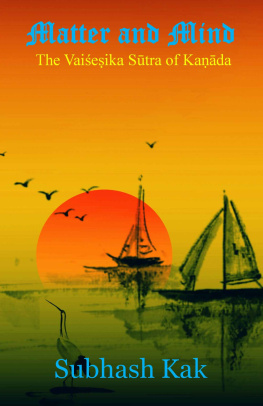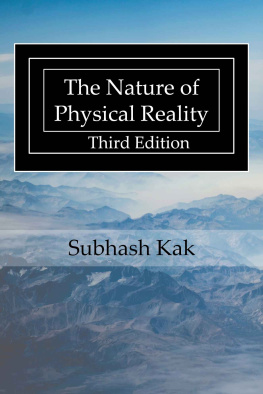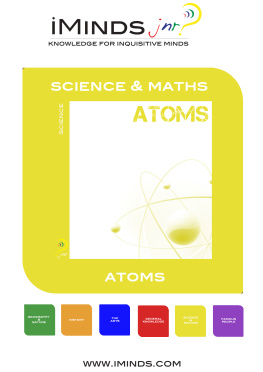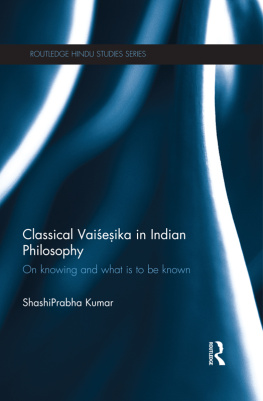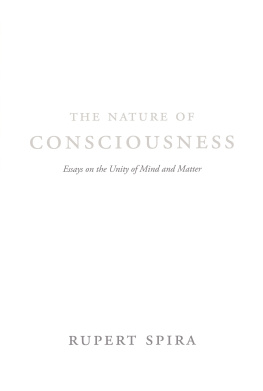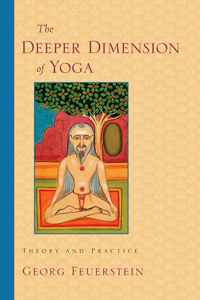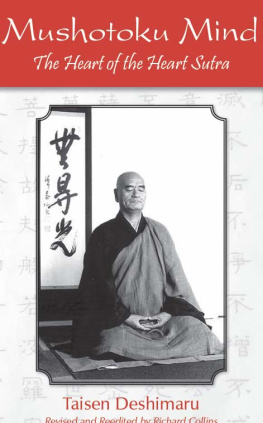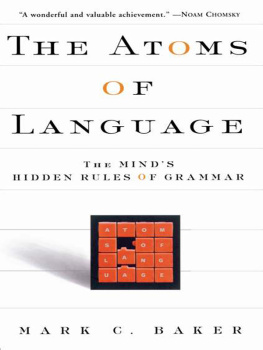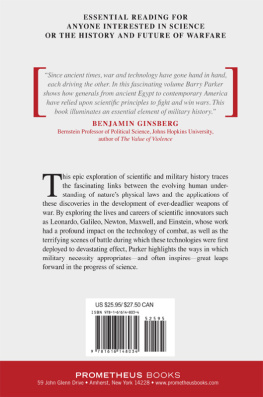Matter and Mind
Also by SUBHASH KAK
The Architecture of Knowledge
The Nature of Physical Reality
The Astronomical Code of the gveda
The Gods Within
Computation in Ancient India
Mind and Self: Patajalis Yoga Stra and Modern Science
The Praj Stra: Aphorisms of Intuition
The Wishing Tree
In Search of the Cradle of Civilization
The Avamedha
Arrival and Exile
The Loom of Time
Matter and Mind
The Vaieika Stra of Kada
Subhash Kak
Mount Meru Publishing
Copyright 2016 by Subhash Kak
All rights reserved. No part of this book may be reproduced or transmitted in any form or by any means, electronic or mechanical, including copying, photocopying, scanning, and recording or by any information storage and retrieval system without written permission from the author, except for material already in public domain or for the inclusion of brief quotations for research or review.
________________________________________________________________
Library and Archives Canada Cataloguing in Publication
Kada
[Vaieikastra. English]
Matter and mind: the Vaieika Stra of Kada / [translation and commentary by] Subhash Kak.
Translated from Sanskrit.
Includes bibliographical references and index.
Issued in print and electronic formats.
ISBN 978-1-988207-13-1 (paperback).--ISBN 978-1-988207-14-8 (html)
1. Kada. Vaieikastra. 2. Vaieika--Early works to 1800. I. Kak, Subhash, 1947-, editor, translator II. Title. III. Title: Vaieikastra. English.
B132.V2K313 2016 181'.44 C2016-904262-6
C2016-904263-4
________________________________________________________________
The views expressed in this book belong solely to the author and do not necessarily reflect the views of the publisher. Neither the author nor publisher is liable for any loss or damages resulting from the use of information presented in this book. Neither the author nor publisher makes any representation or warranty with respect to the accuracy or completeness of the information presented in this book.
Published in 2016 by:
Mount Meru publishing
P.O. Box 30026
Cityside Postal Outlet PO
Mississauga, Ontario
Canada L4Z 0B6
Email: mountmerupublishing@gmail.com
ISBN 978-1-988207-14-8
Cover image: Pixabay (https://pixabay.com)
CONTENTS
PREFACE
Our ideas and theories are based in consciousness, yet science has no place for it. In our minds eye, we see the universe as stars and planets in motion with us as specks of dust in the enormous expanse of space and time. We speak of principles of symmetry and information as fundamental to physical laws, but these are characteristics primarily of cognition, whereas our physics is based on things, their qualities, and their mutual interactions.
In biology one speaks of beauty as playing an important purpose through natural selection, but beauty can only exist in consciousness. We wish to describe the world through relationships of things, but these descriptions implicitly assume a being.
There is one unique system of physics that considers not only matter but also observers (and consciousness) and this system is described in the Vaieika Stra, which presents a conceptual representation of space, the gross visible matter composed of four different kinds of atoms, and sentient observers.
The originator of the Vaieika is Kada (sometimes also called Ulka), who is believed to have lived around 600 BCE or not much later thereafter. The Vaieika is believed to precede the ancient system of the Nyya, or logic, which is closely tied to it, and it is known to the physician Caraka who quotes it in his Strasthna. In both the Nyya and the Vaieika, minds are not empty slates; the very constitution of the mind provides some knowledge of the nature of the world. The four means (pramas) through which correct knowledge is acquired are direct perception, inference, analogy, and verbal testimony.
In my study of the Vaieika, I have become convinced that Kada is perhaps the greatest natural philosopher before Newton, if for nothing else than the breadth of his conceptual system. He considers symmetry arguments in relation to physical law, defines causality clearly, and anticipates much of Newton in his laws of motion. Further, he does something extraordinary by creating a formal system that includes space, time, matter, and observers and explaining how subjective experiences (qualia) arise.
Sadly, there are no contemporary studies of the Vaieika Stra exploring its physics content and the last major commentary on it, titled Upaskra, was written by akara Mira in the 15 th century. A manuscript of Upaskra in Miras handwriting has a date corresponding to 1473 CE on it (stri, 2002). Brajendranath Seal who wrote a general summary of Indian physics in 1915 quoted akara Mira extensively. More recent Vaieika studies have emphasized issues of interest to philosophers rather than to physicists (e.g. Halbfass, 1992; Chakrabarty, 2003; Kumar 2013). The tradition of seeing Nyya and Vaieika as one larger philosophical school has continued to garner the most attention (as in Matilal, 1977) with the focus on logical and linguistic analyses of the stras.
The beginnings of this translation and commentary go back about ten years when I asked my pupil Roopa Narayan, who was then in the United States, to study it but she had to return to India and abandon the project after a few years. The final push for this translation and commentary was the request for an article on Indian physics for an encyclopedia which eventually grew to a size that it needed to be published as a book.
This study is not concerned with the history of the Vaieika and my purpose is to delve into Kadas system ignoring the modifications that were introduced by later commentators.
The introduction is a preliminary analysis of the Vaieika. As one can see, the stras have much of relevance for the contemporary debates on mind and matter, and how sentient beings make sense of the universe and have agency in a world governed by laws.
Subhash Kak
Stillwater, Oklahoma
May 26, 2016
INTRODUCTION
The Upaniads (e.g. Taittirya and vetvatara) present the doctrine of five elements ( mahbhtas ) that are named earth ( pthiv ), water ( pas ), fire ( tejas ), air ( vyu ), and ether ( ka ), that represent mass, fluidity, light and fire, gaseousness, and the substratum for vibration. It is explained that since the same substance changes its phase based on heat or cold, the elements of each are present in every substance.
Since earth, water, fire, air, and ether are loaded words, from now one we will generally use the Sanskrit terms for the elements. The Chndogya Upaniad says this of the relationship between the elements of the universe: From this self (tman), ka arose; from ka vyu; from vyu tejas; from tejas pas; from pas pthiv. In the nti Parvan in the Mahbhrata, the sequence of dissolution of the physical universe is as follows: Under extreme heat, pthiv becomes pas, then tejas, then vyu, then ka, then space, then mind, then time, then energy, and finally universal consciousness.
The transformation sequence of the elements clearly shows that atoms appear from space and prior to that from consciousness. Evolution and transformation is one of the basic characteristics of the system of five elements. Indian physics is a logical system building upon this doctrine that strives to analyze physical reality in a surprisingly comprehensive manner.
General ideas of evolution of the physical universe and how elementary atoms arise out of the subtle tanmtras, explaining the origin of the atoms of Vaieika, are part of the Skhya system and are also touched upon in Vednta texts. Astronomy siddhntas provide us further information on how motion was considered in astronomy (e.g. Burgess, 1860; Shukla and Sarma, 1976). Additional scattered references of relevance to physical ideas are to be found in the Puras, the Yoga Vsiha and the Mahbhrata and of chemical ideas in the yurvedic literature.
Next page
